 полная версия
полная версияBeeton's Book of Needlework
The principal stitches used in guipure d'art are POINT D'ESPRIT, POINT DE TOILE, POINT DE FESTON, POINT DE REPRISE, POINT DE BRUXELLES, and WHEELS and STARS. POINT D'ESPRIT is worked with finer cotton than the foundation, say No. 10 on a foundation of No. 6. It consists of a succession of small loops, as will be seen clearly in the illustration. The learner should begin from the mark * No. 503, and working a row of loops the length required, turn the frame and work loops on the opposite half of each square intersecting the first worked loops in the centre of each intervening bar of netting. A careful examination of Nos. 503 and 506 will explain this more clearly than is possible in words.

<
POINT DE TOILE, or LINEN STITCH, is plain darning under and over each thread; this forms a fine close groundwork, and is much used in guipure d'art. Care should be taken to keep the same number of stitches in each square, both along and across; the number of threads shown in illustration No. 504 is 4 only, but 6 and even 8 are used in many netted foundations in fine patterns.

POINT DE FESTON is worked by a series of overcast stitches, as seen by illustration 506, which clearly shows the manner of working. The frame is turned at each stitch, the stitches are taken across the squares, and increase in length at the top of the square.

POINT DE REPRISE, or DARNING, is worked by stretching 2 or 3 threads over 1, or 2, or more squares. The thread is darned over and under, and the needle used to arrange the last stitch while passing through to form the next. This stitch is very easily acquired. It is always worked with coarser thread than the foundation; No. 2 thread should be employed for a coarse groundwork. No. 510 shows this stitch used to form stars, figures, &c.


POINT DE BRUXELLES, as shown on pages 506 and 507, is a kind of loose button-hole stitch, and is used for forming various patterns and for filling up squares. It also forms "leaves," when the number of stitches is decreased each row until the leaf finishes off in a point. Nos. 509 and 510 clearly show this stitch.


WHEELS are easy to work, and are begun in the centre. Four threads are taken across, as shown in design No. 511; the thread is twisted in bringing it back to the centre, and the wheel formed by passing the thread under and over the netting and the crossing threads. It is fastened off on the back of the several wheels.

Wheel No. 513 is a square wheel, and is worked in the same manner, with the addition of point d'esprit loops, through which, and under and over the cross-twisted threads, 4 or 5 rows of thread are passed.
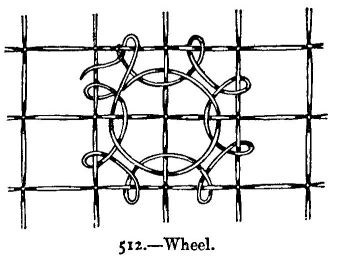
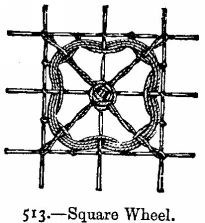

STARS are of various form, as shown in Nos. 516, 517, 518, 519, and 520.
No. 516 is worked in point de feston (see page 507) round a single square hole, which is filled in by a small wheel or rosette.
No. 517 is worked in point de feston and point de Bruxelles, alternately round a centre simply crossed by point d'esprit threads.

No. 518 is more elaborate, and is worked thus:–Begin at the place marked a; twist the linen thread 3 times round the nearest thread, draw it on to the knot b; repeat this 3 times, following the order of the letters; twist the linen thread also between the threads, as can be seen from the illustration, and fasten it underneath the knot a; for the wheel fasten on the cotton afresh and work the remaining pattern in darning stitch (point de reprise).
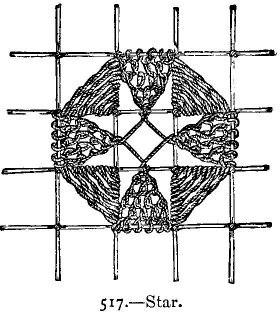
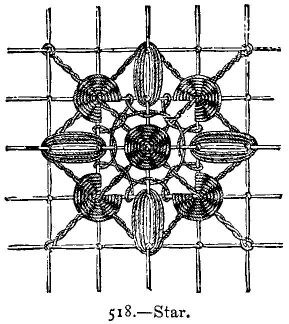
No. 520 consists of a double cross formed by twisted loops of linen thread. Copy these loops exactly from illustration 520.
One part of the straight cross lies underneath, then comes the slanting cross, and lastly, the other part of the straight cross.
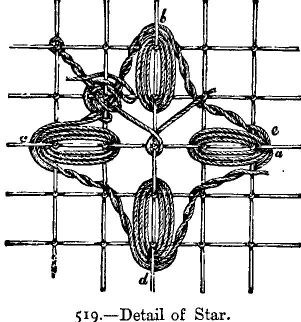
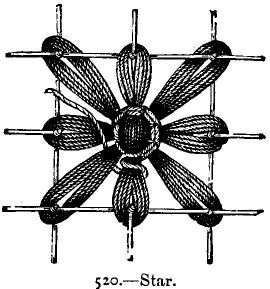
In the centre the loops of linen thread are fastened with two rounds of stitches. (See illustration 520).
OVERCAST STITCH is worked like embroidery overcast, and forms the stems of the flowers and leaves of guipure d'art; it is worked over one or two coarse threads. It is employed in No. 530, and forms the triangles in the centre of the middle squares.

521.–Insertion in Guipure d'Art.
Materials: Guipure frame netting of 6 holes wide; Mecklenburg thread No. 8 or 10; needle No. 7.
For the netted foundation, which is six holes wide, begin at one corner with 2 stitches, work 5 rows, at the end of each of which increase 1 stitch, continue to work the strip with the same number of stitches, alternately decreasing 1 at the end of one row and increasing 1 at the end of the next. For decreasing net 2 stitches together, for increasing net 2 stitches in the same hole. When the strip is sufficiently long, complete it by decreasing in the same proportion as the increasing at the beginning. As the pattern is so clearly shown in the illustration, it will be very easy to work from it. It is worked in point de feston and star wheels; the border is in point d'esprit. The insertion is finished on either side with a row of button-hole stitches.
522.–Lace Border in Guipure D'Art.
Material: Messrs. Walter Evans and Co.'s Mecklenburg thread No. 8 or 10.
This border may be used for various purposes; it makes a pretty edging for toilet cushions if worked in fine thread, and looks equally well for trimming couvrettes, &c., in No. 2 thread. The netting is nine holes wide, the stitches employed are point d'esprit and point de feston, the edge is in buttonhole stitch, the netted ground is cut away outside the scallops.

523.–Square for D'Oyley
Materials: Frame; 1 square of netting; Mecklenburg reel thread Nos. 8 and 10; needle No. 6.

This square may be used to form part of a couvrette, or a d'oyley, or pincushion. The three other corners of the square are worked exactly like the one seen in illustration; the rosette in the centre is shown in full size. The square is worked in point d'esprit, linen stitch, and point de reprise. Each of the leaves of the foliage is worked in one hole of the netting; they are worked by throwing the cotton three times across the hole, and working darning stitch on them. The stem is worked in overcast on the thread of the netting. The daisy in the centre is worked like the leaves, each leaf taking up one or more holes of the netting.

524 and 525.–Corner Borders in Guipure d'Art.
Materials: Messrs. Walter Evans and Co.'s Mecklenburg thread No. 2 for couvrettes, No. 8 for pillow-cases, No. 16 for lace edgings.
These corner borders are suitable for pillow-cases or small couvrettes; the stitches worked on these patterns are linen stitch, darning stitch, point de Bruxelles, and wheels. The edge is formed by buttonhole stitches. The netting is cut away after these are worked.

526.–Strip of Insertion in Guipure d'Art.
Material: Messrs. Walter Evans and Co.'s Mecklenburg thread No. 8.
This strip of insertion is 8 stitches wide, and is worked in zigzag lines of point de feston, with a border of point d'esprit and point de toile; a four-point star occupies the centre of the triangle left by the zigzag line. This pattern is so easy to work that it hardly needs description, the only part requiring care being the squares of point de feston; these are begun in the centre, and the thread should be drawn rather tightly so as to form a good square.

527.–Small Square.
Materials: Frame; Messrs. Walter Evans and Co.'s Mecklenburg thread No. 4, 6, or 8 for the netting, and No. 16 for the pattern.

Work over a mesh measuring 2-1/10 inch round the foundation of each square, which has seven stitches in length, and as many in breadth. It is embroidered in darning stitch, and point d'esprit, and wheels. The outer edge is worked round in button-hole stitch. Larger squares are worked in the same manner, only a few rows larger in length and breadth. The squares are fastened together with a few stitches, and sewn on the pincushion or any article they are intended to ornament.
528.–Insertion in Guipure d'Art.
Materials: Messrs. Walter Evans and Co.'s Mecklenburg thread No. 8, or 16 for very fine work.
This strip of insertion is very pretty, and can be used for all kinds of lingeries. The size of the material depends, of course, on the use to be made of the insertion. The guipure pattern is worked in linen stitch and point d'esprit, the raised leaves in darning stitch. The edges are worked round with buttonhole stitches.

529.–Rosette in Guipure d'Art.

Material: Messrs. Walter Evans and Co.'s Mecklenburg thread No. 6.
This rosette is worked in point de toile and small wheels. A larger wheel occupies the centre, and is ornamented with a round of overcast.
530.–Quarter of a Square in Guipure d'Art.
Materials: One guipure frame; Mecklenburg thread Nos. 6 and 12; needle No. 7.

This pattern shows, in full size, one quarter of a square in guipure d'art. The outer border is in point d'esprit, then comes a border in linen stitch. There are large stars in the corners; these stars are worked in raised darning stitch only, and fastened on the netting at the points of each brand; in the centre of the star there is a wheel (see No. 515) edged with buttonhole stitch. The pattern for the centre, one quarter of which only is seen in the illustration, consists of 4 branches forming small triangles in point de Bruxelles, 4 open-worked stars or wheels worked over 4 holes of the netting, and a four-branched centre of point de feston with a wheel in the middle.
531 and 532.–Square Patterns in Guipure d'Art.
Materials: Messrs. Walter Evans and Co.'s linen thread No. 2 for the netting, and their Mecklenburg thread for the guipure stitches No. 8.

No. 531. The outer border of this pretty square is worked in point d'esprit, the inner border in point de toile; then follows a round of small wheels or rosettes.
For these, fasten the cotton to one of the knots of the first square stitch of this round, work one loop upon each of the three other knots, so as to form a slanting cross; then work round the centre point of the cross, passing alternately under and over its branches, then twist the cotton over the threads of the foundation until the next square is reached, and begin another wheel.

The centre of No. 531 is composed of wheels and point de reprise; the pattern round the centre is worked in point de feston, differing a little from that given on pages 505 and 506, but the illustration clearly shows the difference.
No. 532 has similar borders to No. 531; the centre is occupied by a star (see page 512) in point de feston; four large wheels surround this; the square stitches between are filled with small wheels and with groups of long loops, fastened together in sheaves. Point d'esprit and point de toile, worked one way only, complete this square.
533 to 536.–Four Patterns in Guipure d'Art.
Material: Messrs. Walter Evans and Co.'s Mecklenburg thread No. 2 or 16, according to the size of the work.
These four patterns will be found useful for filling up small squares, or for varying the usual groundwork of point d'esprit.

No. 533 is a succession of point de feston stitches, which half fill each square of the netting. This pattern must be worked with great regularity.
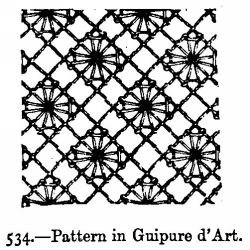
No. 534 consists of a kind of double point d'esprit.
No. 535 is a thread twisted and taken across each square, and resembles lace stitches.

No. 536 is a succession of small close wheels, intermingled with point d'esprit. This grounding is very effective.
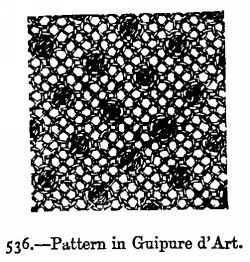
537.–Lace Border for Veils, &c.
Materials: Messrs. Walter Evans and Co.'s Mecklenburg thread No. 16; strip of square netting of the required length; oblong frame.
This simple border is easily and quickly worked. The edge is overcast, the ground worked in point d'esprit, the border in point de toile, and the pattern in point de reprise. When completed the netting is cut away from the overcast edge.

538 and 538a.–Squares in Guipure d'Art.
Materials: 2 squares of netting of 8 holes; Messrs. Walter Evans and Co.'s Mecklenburg thread No. 10 or 16, according to the fineness required.

These squares are very pretty for cravat ends, cuffs, or handkerchiefs. They are worked on netting with very fine cotton in the usual manner, beginning on two stitches in one corner The different stitches of the guipure darning can be distinctly seen in illustration, and are point de feston, point de reprise, point de toile, and point d'esprit on No. 538, and the same stitches surround a wheel in No. 538a.


539.–Insertion in Guipure d'Art.
Materials: Messrs. Walter Evans and Co.'s Mecklenburg thread Nos. 8 to 16; strip of netting length, required.
This insertion is worked in point de toile, and wheels worked in point de feston. The ground in point d'esprit.
540 and 541.–Square in Guipure Point de Venise (Reticella)
Materials: Coarse or fine linen; Messrs. Walter Evans and Co.'s Mecklenburg thread No. 4 or 12.


This square is worked in the so-called point de Venise, together with other squares; it is very pretty for covers, toilet cushions, &c. It is worked on coarse or fine linen, according to the use you wish to make of it. Prepare a square piece of linen, by drawing out long and cross threads, so as to form perfect squares. In the pattern No. 540, which is worked on fine linen, 28 threads have been drawn out, both the long and cross way; 8 squares are formed in this way each time that 28 threads have been drawn out; leave 7 or 8 threads of the ground, which form the framework. Then fasten the piece of linen on card-board, and work close button-hole stitch round the inner edge Then work with darning stitch over the long and cross threads of the ground.
From No. 541, which shows the fourth part of the square 4 times larger than full size, it is easy to see how the framework is darned. When the latter is entirely darned, work the patterns in the different squares in button-hole stitch. The circular and serpentine patterns consist of 3 rows of button-hole stitch; the patterns which imitate whole rosettes and half rosettes are worked in rows of button-hole stitch. For each row the thread must be first drawn from one place to the other, as can be seen in illustration, and fastened on the framework. The knots in the last button-hole stitched row are made by working in each stitch when completed, another stitch, and drawing the cotton again through the first completed knot. It is easy, however, to work all the patterns from No. 541. The dotted lines in the right-hand corner show the direction of the patterns which are wanting there. The square is edged all round with an open-work hem, which can also be worked from No. 541.
542 and 543.–Corner Patterns in Guipure d'Art.
Material: Messrs. Walter Evans and Co.'s Mecklenburg thread No. 14.
These patterns are very pretty for cushions, handkerchiefs, &c. The netted ground is to be worked from the corner. Cast on 2 stitches, and work in rows backwards and forwards, increasing 1 stitch at the end of every row. The pattern is worked in point d'esprit, linen, and darning stitch, as can be seen in illustration.

544.–Flower for Ornamenting Cravats and Caps in Guipure d'Art.
Materials: Black or coloured silks, or Messrs. Walter Evans and Co.'s Mecklenburg thread No. 10.

This pattern is worked with middle-sized light-coloured purse silk in guipure d'art on netting. This pattern can also be worked with white thread or black silk in point de reprise.
545.–Work Basket with Covering of Darned Netting.
Materials: Bamboo cane basket; blue satin; cardboard; netting; Messrs. Walter Evans and Co's Mecklenburg thread No. 16.

This elegant basket is made of bamboo cane and blue satin, fastened on cardboard, and covered with guipure d'art. The stand of varnished bamboo is twelve inches long, seven and a half inches wide, and five and a half inches high. The case inside is made of cardboard, covered on both sides with blue satin, and the guipure d'art on the outside only. The stitches used are point de toile, point de reprise, and point d'esprit.
546 and 547.–Squares in Guipure d'Art.
Materials: Messrs. Walter Evans and Co.'s Mecklenburg thread No. 12 or 20; and point d'esprit according to the fineness required.

Both these square patterns are suitable for ornamenting lingerie, cravats, collars, &c. Repeated at regular intervals on a larger centre, they are likewise suitable for couvrettes, cushions, pillow-cases, &c.; they are worked in darning and linen stitch.

548.–Insertion in Guipure d'Art.
Materials: Strip of netting 6 holes wide, and of the required length; Messrs. Walter Evans and Co.'s Mecklenburg thread No. 8 or 12.
This simple insertion consists of double rows of wheels worked at each side of a strip of point d'esprit, an edge of buttonhole stitches being worked between the rows.
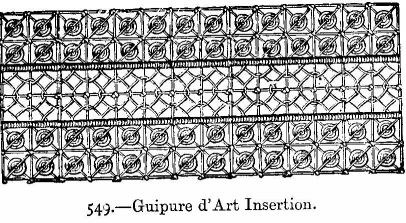
550 and 551.–Squares for Antimacassar.
Materials: Square of netting of 12 holes; Messrs. Walter Evans and Co's Mecklenburg thread No. 8.

No. 550 is very quickly worked. The border and groundwork in point d'esprit, the centre star in point de reprise, the pattern in point de toile. Wheels fill in the four holes in the centre of the squares.
No. 551 has a border in point d'esprit, the star is worked in point de feston, the other stitches are point de toile. Wheels in part of star pattern No. 518.

552 and 553.–Borders in Guipure d'Art.
Material: Messrs. Walter Evans and Co.'s Mecklenburg thread No. 8 or 16.

These corner borders are very suitable for couvrettes, and, worked with fine thread, for pocket-handkerchiefs. The netted ground of the borders is to be worked in the size seen in illustration; for the border No. 553 darn the ground in button-hole stitch, darning stitch, point d'esprit, and point de feston; the pattern No. 552 is worked in linen stitch and point d'esprit; small wheels are also to be worked. Both borders are to be worked round in button-hole stitch; the netted ground is cut away along the outside.

554 and 555.–Squares in Guipure d'Art.
Materials: Messrs. Walter Evans and Co.'s Mecklenburg thread No. 20; netted squares of 7 and 8 holes.

These two small squares are suitable for ornamenting cravats, lappets for caps and lingeries. They are worked in darning and linen stitch. The centre part of the square, No. 554, is a small wheel covered with raised stitches.

556.–Square in Guipure d'Art.
Material: Messrs. Walter Evans and Co.'s Mecklenburg thread No. 12.

